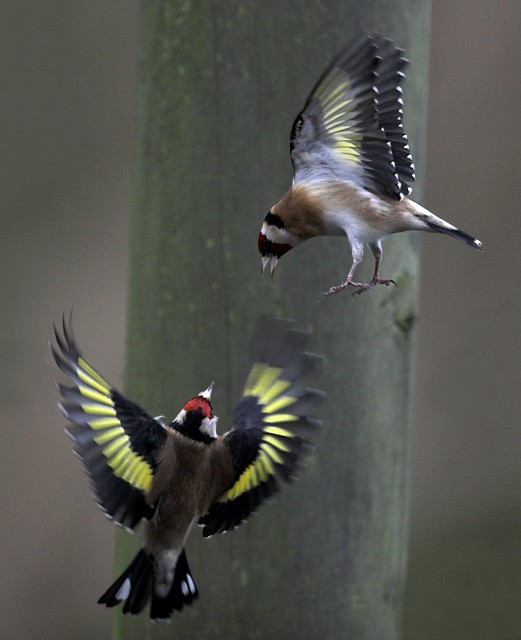World's biggest wildlife survey expected to show impacts of warmer, wetter weather
Just one hour spent looking out into your garden this weekend (26th-27th January) can make a valuable contribution to our understanding of changing bird populations, says the RSPB. Up to half a million people are expected to take part in this year's Big Garden Birdwatch, helping to provide a picture of the impacts on common birds of rising temperatures, last year's wet summer and the increasing range of foods put out to attract birds. In particular the RSPB anticipates there will be changes to the numbers of Goldfinches and Blue Tits.
The colourful Goldfinch is expected to break into the top 10 for the first time in the survey's 29-year history. Many of our Goldfinches go to southern Europe for the winter, but the RSPB is expecting that more will stay in the UK this year due to milder temperatures.

Goldfinch, Leominster, Herefordshire (Photo:
George Ewart)
Dr Andre Farrar of the RSPB said: "UK temperatures continue to rise; the last six years (2002-2007) have been the warmest since records began. Over the same time, numbers of Goldfinches seen in gardens during the Big Garden Birdwatch have steadily increased. Last year they were placed 11th - they would certainly make an attractive addition to the 2008 top 10."
Over the past 30 years Goldfinch numbers have increased by half1 and initial reports show that last year was a very good breeding season with twice as many chicks as the previous year2. Goldfinches have not just benefited from changes to the climate; changes in gardening practices have also helped them. Dr Farrar added: "Putting out nyjer seed, to encourage goldfinches, is becoming increasingly popular. Also, the trend for less manicured gardens encourages plants such as thistles and teasels, which provide vital seeds for finches."

Goldfinch, undisclosed site, Lancashire (Photo:
Tom Charles)
While the RSPB expects good things for Goldfinches in this year's Big Garden Birdwatch, last year's extremely wet breeding season may have big impacts on Blue Tits. In 2007 Blue Tits, which normally have only one brood per year, experienced their worst-ever breeding season, with just over half of young Blue Tits fledging3.

Blue Tit, Silent Valley, Gwent (Photo:
Mike Warburton)
May to July 2007 was the wettest in England and Wales for more than 200 years. Heavy rain washing caterpillars off leaves and the later emergence of caterpillars are likely to have caused a food shortage for Blue Tits. Dr Farrar said: "We know that in the last 40 years Blue Tits have begun laying eggs earlier and earlier. This means they are increasingly out of sync with the appearance of caterpillars. Last year, not only did they have to deal with this, but they also had the terrible weather conditions. I would expect numbers seen during the Big Garden Birdwatch to decrease this year." While wet conditions may have been detrimental to Blue Tits, the RSPB hopes Blackbirds and Song Thrushes will have thrived. Last year's warm, wet summer will have made it easier to find snails, slugs and earthworms to feed their young.

Song Thrush, Girton, Cambridgeshire (Photo:
Garth Peacock)
Sarah Kelly, the RSPB's Big Garden Birdwatch co-ordinator, said: "The great thing about Big Garden Birdwatch is that anyone can do it. You don't need to be an expert, all you need is a pen and paper. It's easy, it's fun and it only takes an hour. Grab a cuppa, sit down, relax and enjoying looking at your garden and the birds in it. Just record the highest number of each species seen at any one time and send us your results. That's it!"
Last year's results
The table shows the average number of the top 10 species of birds recorded per garden across the UK in the 1979 Big Garden Birdwatch, and compares this with the results from 2007 survey.
| Species | Average per garden in 1979 | Average per garden in 2007 | % change |
|---|---|---|---|
| House Sparrow | 10.00 | 4.42 | -56 |
| Starling | 15.00 | 3.68 | -76 |
| Blue Tit | 2.44 | 2.82 | 16 |
| Blackbird | 4.00 | 2.26 | -44 |
| Chaffinch | 3.00 | 1.93 | -36 |
| Collared Dove | 0.28 | 1.56 | 456 |
| Wood Pigeon | 0.20 | 1.53 | 666 |
| Great Tit | 0.90 | 1.37 | 52 |
| Robin | 2.00 | 1.26 | -37 |
| Greenfinch | 1.00 | 1.21 | 21 |

Wood Pigeon, Pennington Flash CP, Manchester, Greater (Photo:
Sue Tranter)
With 28 years' worth of data and up to half a million people expected to participate, the results give an important, early indication of garden bird trends. Gardens remain a vitally important habitat for birds and other wildlife. Many of the UK's garden birds are doing very well as a result of people providing safe havens for them in their homes and gardens. Providing food, water and shelter is not only helpful to birds, it will also encourage a wider variety of birds to count during the Big Garden Birdwatch.
To take part, simply spend one hour over the weekend of 26th/27th January, counting the birds in your garden or local park, and record the highest number of each bird species seen at any one time.
Visit the RSPB website www.rspb.org.uk/birdwatch for more information and to submit your results online.
1 The long-term trend for Goldfinches from 1970-2005 shows an increase in breeding birds of 50%. The Breeding Bird Survey trends shows a 21% increase from 1994-2006.
2 The British Trust for Ornithology’s Constant Effort Sites Scheme shows a 54% increase in juvenile abundance in 2007, compared to 2006 figures.
3 The British Trust for Ornithology’s Constant Effort Sites Scheme shows Blue Tit productivity to be 48% below the long-term average in 2007.

